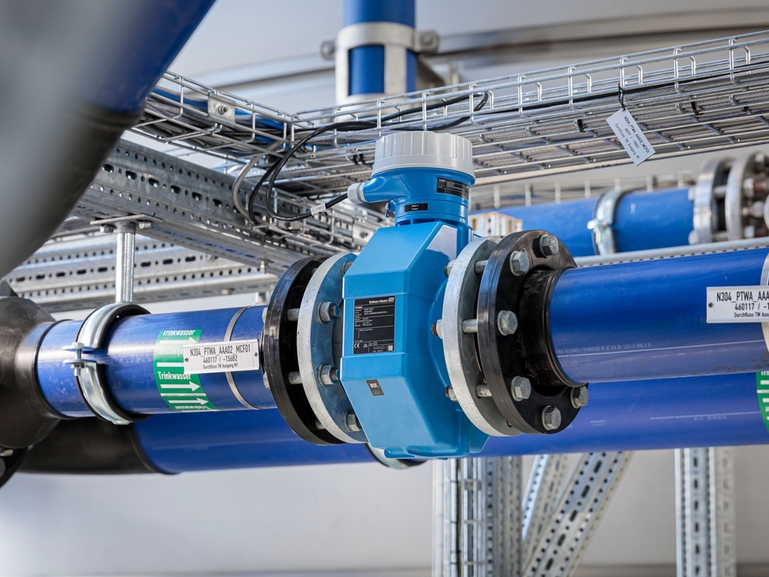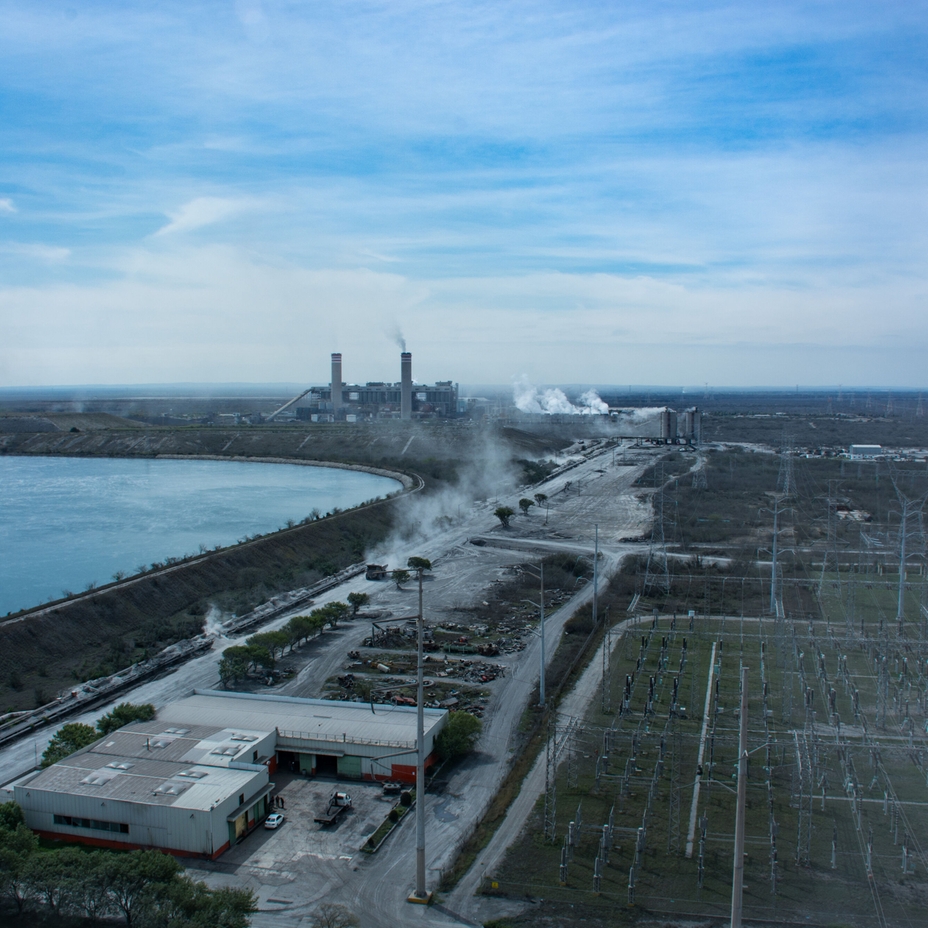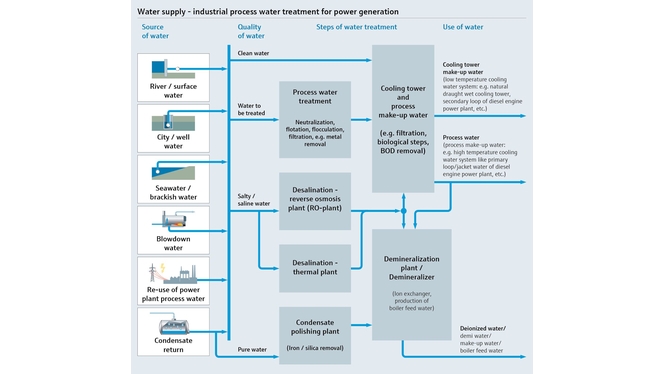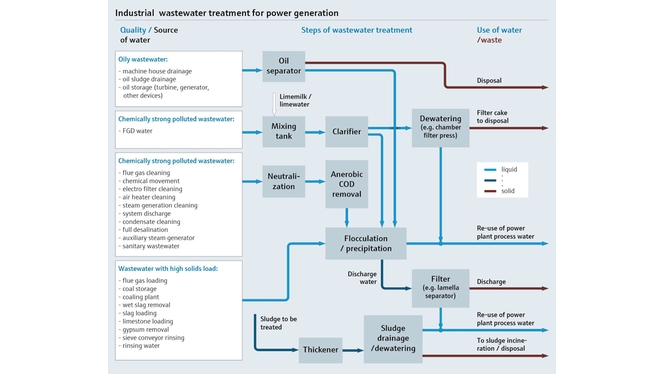Wherever the water in your plant comes from, it needs to be treated to be of the right quality for every use. Checking that the power plant water chemistry and flow are correct, means using the best tools. And you need to be able to prove it, by having the right readings and data trail to comply with regulations, alongside manufacturer warranties for built-in parts. Above all, accurate and reliable data means being able to safely recycle water to run your plant as efficiently as possible.
The water cycle in power plants

Reliable flow measurement of de-mineralized water
Pure, deionized, de-mineralized water in the water / steam circuit needs to be accurately and reliably measured. The flowmeters most commonly used in this application are dp flow solutions with primary elements such as orifice plates. But such pressure-based measuring systems drift over time and need recalibration. There are volumetric alternatives that can offer better performance, provide more outputs, and reduced inlet runs: using vortex, ultrasonic and thermal mass technology.
Our expertise in the field

Reliable silica analysis – condensate polishing plant outlet
Steam entering the turbines of a power plant needs to be as silica-free as possible. Silica is highly soluble in water and once inside the turbine it forms deposits on surfaces, hindering heat transfer and reducing overall efficiency. In order to produce water with as low in silica content as possible, thus preventing unscheduled downtime, you need to be able to accurately detect and measure it.
Our expertise in the field
The

Optimized conductivity analysis in desalination plants
Water of varying quality is used in energy production and sourced locally. Conductivity is an important measure of the salinity and quality of the water. By knowing the conductivity early on, you can decide how and where to use the water, and how much of it to desalinate. Whether you are using a thermal evaporation process or reverse osmosis (RO) membrane process, or sourcing sea water or brackish water, accurate conductivity measurement is key to reducing energy use and operating costs.
Our expertise in the field

Reliable pH measurement in cooling towers
To protect your cooling towers, you need to keep the pH value of the cooling water under control, otherwise you risk rust and corrosion. Maintaining the pH value at the corrosion minimum of the plant using either an acid or caustic control scheme solves the problem. However, the cooling tower water is nebulized and penetrates every junction point with conventional wiring, even the critical sensor connections, and causes gradual changes in measured values.
Our expertise in the field
With the Memosens sensor, all this is no longer an issue as it has no metallic parts and is completely watertight. It is 100% reliable and achieves digital data transmission via inductive, corrosion-free bayonet connection. The sensor is installed easily, starting with an immersion assembly in the cooling tower sump up to flow-through assembly in glass-fiber reinforced plastic pipes.
- Avoid the effects of moisture, corrosion and salt bridges thanks to non-contact digital data transmission
- 100% reliable: digital data transmission via inductive, corrosion-free bayonet connection, guaranteed EMC safety
- Plan maintenance with pre-calibrated ‘plug & play’ sensors that can be replaced by non-specialist staff

Accurate, maintenance-free measurement of water supply
When extra water is needed in the power plant cooling system, or for feedwater in the steam circuit, you need a reliable flowmeter that can handle all kinds of water sources – from rivers, wells, the sea or elsewhere in the power plant. The flowmeter has to be self-cleaning, so it can continue to take accurate measurements, and be able to handle big volumes of water containing a range of impurities.
Our expertise in the field
The compact Proline Promag electromagnetic flowmeter is especially designed for raw water use and is available in sizes from 0.08 in. to 90 in. (2 mm to 2400 mm). Simple to use, easy to set up and operate, with pulse, analog and relay outputs, it is a fit-and-forget appliance that works reliably in main flow pipes.
- Remote commissioning coupled with easy verification using Heartbeat Technology – no need to take the device out of the line
- Self-cleaning Electrode Cleaning Circuit keeps electrodes free from deposits
- Measurement without inlet and outlet runs or pressure drop in the line
- Ultrasonic clamp-on versions available: installation without process interruption
Benefits
Thanks to our extensive experience in the power & energy and water industries, amongst others, we are experts in water treatment for power generation. From process water to wastewater, Endress+Hauser offers a vast portfolio of instruments and tailored solutions to monitor the water chemistry in your power plant. Cutting-edge sensor technologies like Memosens enable you to surveil your processes even more reliably, while saving you costs and time.
Key facts
> 65
years of experience in the industrial process engineering industry
Key facts
> 8,000
patents and patent applications
Key facts
40%
longer service life of Memosens digital sensors
How we can help
Digital readings, data storage, reporting – digital tools take the hassle out of proving compliance and instrument warranties. Our sensors and measuring tools cover the whole range of plant needs, and generate data that makes life easy for you and your laboratory partners. They can automatically check and clean themselves, need minimal maintenance and alert you when they need replacing. From the smallest sensor to the SWAS panel, we bring you a complete digital water monitoring solution.
- Reliable flow measurement and water analysis instrumentation for optimized water chemistry
- Increased plant availability thanks to predictive maintenance
- Non-contact digital data transmission avoids measurement errors due to moisture, corrosion and salt bridges





